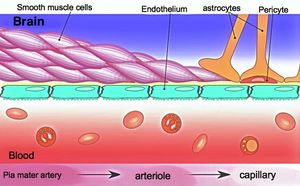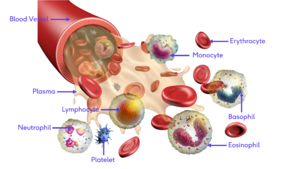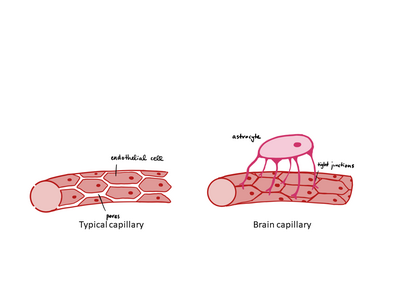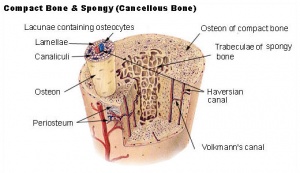Fenestrated Capillary Continuous Capillary Sinusoidal Capillary
Introduction [edit | edit source]
Capillaries are:
-
Bood vessels that do not have the muscular/elastic tissue of other blood vessels.
- Small (smaller than any other blood vessels) and thin-walled (to help substances be transported through organisms).
- Composed of: a single layer of simple squamous epithelium; a basement membrane known as tunica intima; scattered connective tissue cells called pericytes (see image R)
- 5-10 μms big (connecting arteries and venules) and enable the moving of water, oxygen, carbon dioxide, as well as many other nutrients and waste chemicals between blood and surrounding tissues. [1] [2]
Physiology [edit | edit source]

The capillary wall is a one-layer tissue so thin that gas and other items (eg oxygen, water, proteins and fats) can pass through them driven by pressure differences. Waste items such as carbon dioxide and urea can move back into the blood to be carried away for removal from the body.
- The Capillary Bed: Capillaries do not function independently. The capillary bed is an interwoven network of capillaries that supplies an organ. The more metabolically active the cells, the more capillaries required to supply nutrients and carry away waste products. capillary bed can consist of two types of vessels: true capillaries, which branch mainly from arterioles and provide exchange between cells and the circulation; vascular shunts, short vessels that directly connect arterioles and venules at opposite ends of the bed, allowing for bypass[3]
- The capillary bed usually moves no more than 25% of the amount of blood it could contain, although this amount can be increased through auto regulation by making the smooth muscle relax in the arterioles that lead to the capillary bed as well as metarterioles making themselves smaller.
- The capillaries do not have this smooth muscle in their own wall, and so any change in their width is passive. Any signaling molecules they release (such as endothelin for constriction and nitric oxide for dilation) act on the smooth muscle cells in the walls of nearby, larger vessels, e.g. arterioles.
- Capillary's ability to move items can be increased by the release of certain cytokines, eg in the inflammatory response.[1]
- During embryological development, new capillaries are formed by vasculogenesis, the process of blood vessel formation occurring by de novo production of endothelial cells and their formation into vascular tubes. The term angiogenesis denotes the formation of new capillaries from pre-existing blood vessels[3]
The 3 types of Capillaries [edit | edit source]

There are a few different structural types of capillaries that research has identified in the human body[2]
1.Continuous capillaries
- These are the most common types of capillaries. They contain small gaps in between their endothelial cells that allow for things like gases, water, sugar (glucose), and some hormones to pass through.
- The continuous capillaries in the brain are an exception. These capillaries are part of the blood-brain barrier, which helps to protect the brain by only allowing the most essential nutrients to cross. That's why the continuous capillaries in this area don't have any gaps between endothelial cells, and their surrounding basement membrane is also thicker.
2. Fenestrated capillaries
- Fenestrated capillaries are "leakier" than continuous capillaries. They contain small pores, in addition to small gaps between cells, in their walls that allow for the exchange of larger molecules.
- This type of capillary is found in areas that require a lot of exchange between your blood and tissues. Examples of these areas include: the small intestine, where nutrients are absorbed from food; the kidneys, where waste products are filtered out of the blood
3. Sinusoid capillaries
-
These are the rarest and "leakiest" type of capillary. Sinusoid capillaries allow for the exchange of large molecules, even cells. They're able to do this because they have many larger gaps in their capillary wall, in addition to pores and small gaps. The surrounding basement membrane is also incomplete with openings in many places.
- These types of capillaries are found in certain tissues, including those of your liver, spleen, and bone marrow (where these capillaries allow newly produced blood cells to enter into the bloodstream and begin circulation)[4]
Pathophysiology [edit | edit source]
Capillaries can be involved in many different disease processes.
- Septic Shock: the immune system responds to bacterial toxins by releasing cytokines and inflammatory mediators such as histamine and nitric oxide. This reaction ultimately leads to vasodilatation and increased capillary permeability, causing leakage of large proteins and fluid into the tissue interstitium. Patients may develop hypotension refractory to fluid resuscitation due to the profound decrease in peripheral vascular resistance and tissue third-spacing caused by the inflammation.
Some diseases are related directly to the capillaries and can present specific signs and symptoms. They can be either hereditary or nonhereditary.
- Hereditaty Diseases : eg (HHT) which also known as Osler–Weber–Rendu syndrome. It is an autosomal dominant disorder with abnormal blood vessel formation in the mucous membranes, skin, and some organs, including the liver, lungs, and brain.
- Benign nevus or spider angioma are solitary or multiple benign vascular lesions present in 10 to 15% of healthy adults and children.
- Systemic capillary leak syndrome is a disease that causes leakage of fluid and proteins out of tiny blood vessels into surrounding tissues. It presents as hypotension, hypoalbuminemia, and hemoconcentration. Elevated white cell count may also be present.[2] Following the announcement of a possible link between the AstraZeneca vaccine and rare blood clots, the European Medicines Agency (EMA) is now investigating whether the vaccine is linked to the very rare blood disorder: systemic capillary leak syndrome (SCLS)[5].
- Atreiovenous malformation syndrome (AVM): an abnormal tangle of arteries and veins that are connected to each other without capillaries in between. These tangles can occur anywhere in the body, but are most often found in the brain and spinal cord. This can cause lesions that interfere with blood flow and oxygen delivery. These lesions may also cause bleeding into the surrounding tissue.[4]
Physiotherapy Implications [edit | edit source]
- Exercise and Angiogenesis: Muscle capillarization is central for the delivery of oxygen and nutrients to the exercising muscle, and thus, capillarization is vital for exercise capacity. A high muscle capillary density means a large muscle-to-blood exchange surface area, short oxygen diffusion distance, and high red blood cell mean transit time. Exercise is the most potent stimulator of angiogenesis in skeletal muscles, and few weeks of exercise training lead to measureable increases in muscle capillarization.
- Untrained subjects may enjoy 10–30 % increase in capillarization after 6–8 weeks of exercise training
- Elite aerobic athletes with years of progressive exercise training express a capillary-to-muscle fiber ratio of more than 200 % of that of untrained individuals.
During exercise, vascular endothelial growth factor (VEGF) is secreted from the muscle fibres to the muscle interstitium. VEGF is the single most important growth factor for expansion of the capillary bed and together with a number of other angioregulatory factors; VEGF levels determine the degree of capillary growth[6]
2. Massage: A common benefit of massage is increased capillarisation. Various techniques are used throughout a massage to help to increase capillarisation. Increased capillarisation can help increase relaxation and decrease pain[7]
References [edit | edit source]
- ↑ 1.0 1.1 Kidz search Capillary Available: https://wiki.kidzsearch.com/wiki/Capillary (accessed 12.7.2021)
- ↑ 2.0 2.1 2.2 Godwin L, Tariq MA, Crane JS. Histology, Capillary. [Updated 2021 Apr 29]. In: StatPearls [Internet]. Treasure Island (FL): StatPearls Publishing; 2021 Jan Available:https://www.ncbi.nlm.nih.gov/books/NBK546578/ (accessed 12.7.2021)
- ↑ 3.0 3.1 Libre Text Capillaries Available: https://med.libretexts.org/Bookshelves/Anatomy_and_Physiology/Book%3A_Anatomy_and_Physiology_(Boundless)/18%3A_Cardiovascular_System%3A_Blood_Vessels/18.2%3A_Arteries/18.2F%3A_Capillaries (accessed 12.7.2021)
- ↑ 4.0 4.1 Health line Capillaries Available: https://www.healthline.com/health/function-of-capillaries#types (accessed 12.7.2021)
- ↑ The Conversation What is capillary leak syndrome and is it linked to the AstraZeneca vaccine Available: https://theconversation.com/what-is-capillary-leak-syndrome-and-is-it-linked-to-the-astrazeneca-vaccine-158812 (accessed 12.7.2021)
- ↑ Gliemann, L. Training for skeletal muscle capillarization: a Janus-faced role of exercise intensity?. Eur J Appl Physiol 116, 1443–1444 (2016) Available: https://link.springer.com/article/10.1007/s00421-016-3419-6#citeas (accessed 12.7.2021)
- ↑ Physio UK Capillarization Available: https://www.physio.co.uk/treatments/massage/physiological-effects-of-massage/circulatory-effects/increased-capillarisation.php (accessed 12.7.2021)
Source: https://www.physio-pedia.com/Capillaries
0 Response to "Fenestrated Capillary Continuous Capillary Sinusoidal Capillary"
Post a Comment